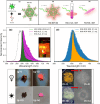Host-Guest Engineering of MOF-808 for Random Lasing and Solid-State Emission
- PMID: 40771858
- PMCID: PMC12322874
- DOI: 10.1021/acsanm.5c02396
Host-Guest Engineering of MOF-808 for Random Lasing and Solid-State Emission
Abstract
Fluorescent organic dyes have a broad range of applications across various fields. However, their use is threatened by stability issues such as photobleaching and aggregation-caused quenching that prevent them from showing solid-state luminescence and being used in high-power photonics applications for a long period. One possibility to overcome these problems is to embed dye molecules within a hosting platform. Metal-organic frameworks (MOFs) are among the best candidates to overcome these problems due to their porous nature, which provides excellent sorption capacities while ensuring stability for potential guest molecules, even in extreme environments. In this work, we investigate the optical performance of rhodamine B and coumarin 343 when interacting with Zr-based MOF-808. On one hand, we demonstrate that inclusion of dye molecules in MOF-808 cavities prevents aggregation-induced quenching, enabling the use of dyes in powdered form and enhancing their emission in solid-state applications, such as fingerprint detection. On the other hand, the dye-MOF interaction in solution reveals that MOF-808 nanoparticles act as efficient scatterers, significantly enhancing random lasing emission by narrowing the emission spectra and reducing the lasing threshold. The lasing performance is shown to be dependent on the MOF concentration and excitation intensity, with an optimal concentration minimizing the threshold and bandwidth. Finally, we demonstrate the feasibility of combining MOF-808 nanoparticles and dyes into polymeric thin films, where the MOFs contribute to halving the lasing threshold, making the system suitable for portable lasing applications.
Keywords: host−guest nanosystems; metal–organic frameworks; nanocomposites; portable lasing device; random lasing.
© 2025 The Authors. Published by American Chemical Society.
Figures




Similar articles
-
Sexual Harassment and Prevention Training.2024 Mar 29. In: StatPearls [Internet]. Treasure Island (FL): StatPearls Publishing; 2025 Jan–. 2024 Mar 29. In: StatPearls [Internet]. Treasure Island (FL): StatPearls Publishing; 2025 Jan–. PMID: 36508513 Free Books & Documents.
-
Management of urinary stones by experts in stone disease (ESD 2025).Arch Ital Urol Androl. 2025 Jun 30;97(2):14085. doi: 10.4081/aiua.2025.14085. Epub 2025 Jun 30. Arch Ital Urol Androl. 2025. PMID: 40583613 Review.
-
Home treatment for mental health problems: a systematic review.Health Technol Assess. 2001;5(15):1-139. doi: 10.3310/hta5150. Health Technol Assess. 2001. PMID: 11532236
-
Short-Term Memory Impairment.2024 Jun 8. In: StatPearls [Internet]. Treasure Island (FL): StatPearls Publishing; 2025 Jan–. 2024 Jun 8. In: StatPearls [Internet]. Treasure Island (FL): StatPearls Publishing; 2025 Jan–. PMID: 31424720 Free Books & Documents.
-
Portion, package or tableware size for changing selection and consumption of food, alcohol and tobacco.Cochrane Database Syst Rev. 2015 Sep 14;(9):CD011045. doi: 10.1002/14651858.CD011045.pub2. Cochrane Database Syst Rev. 2015. PMID: 26368271 Free PMC article.
References
LinkOut - more resources
Full Text Sources
